Bird Watching
Role of Eco Task Force in Restoration of Degraded Ridge Ecosystem
‘The Bhatti Mines’ Delhi
Dr. Surya Prakash
Located in southeastern part of southern ridge in Aravalli valley bridging the two states Delhi & Haryana, Bhatti mines was a home to many wild animals and native flora of Aravalli ranges till 1900 AD. But due to over expansion of Delhi it lost its wilderness
in the process of urbanization in NCR. Over use of land specially for mining in the area made it lifeless with respect to its original natural glory which continued for many decades before the Territorial Army or Eco Battalion officially took over it from
Delhi govt. in 2001.
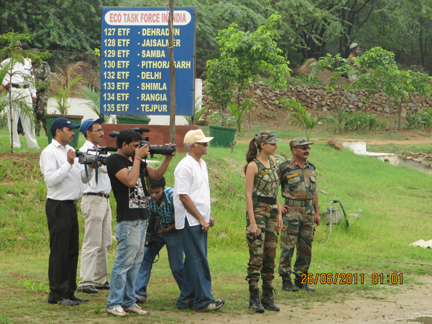
Eco task force at Bhatti Mines, New Delhi
E.T.F. also took nearly 4 years to permanently stop all illegal mining work and restore its original glory as a wildlife sanctuary in its approximately 4000 acres of land.
Today E.T.F has completely transformed this ecologically degraded ecosystem into a very lively ridge ecosystem through sustainable developments in the area by the plantation of species of trees native to Aravallli like Butea monosperma, Salvadora, P.cineraria,
A. nilotica , Anogeissus pendula etc.
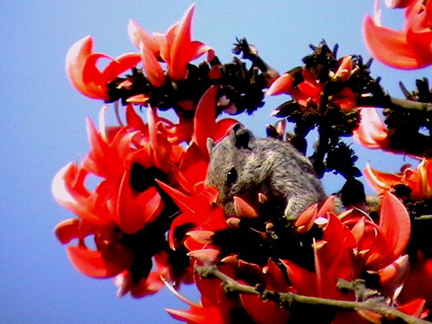
Butea monosperma in Bhatti Mines
The depressions formed due to mining were used as water bodies there are 36 such water bodies.today. Many small to big check dams were constructed in the area where ever there was a natural water fall and man made or natural depressions were present as
a result water table came up. In the year 2011 there was indeed good rainfall so all the water bodies filled up uplifting and restoring the water table in the area. Today because of this effort of E.T.F. the faunal diversity has started blooming and over 100
species of birds can be sighted here including many migratory species ( Winter & Summer) like Green Sandpiper, Common Sandpiper, Crested Pied Cuckoos, Eurasian Golden Oriole etc other than many rare and resident species like Sirkeer Malkoha, Jungle Bush Quail,
Barred Button Quail, Eurasian Eagle Owl, Eurasian Thick Knees and recently photographed Painted Sandgrouses etc. Many species of butterflies like Blue, Plain and Striped Tigers, Pansies, Blues etc.Many reptiles like Monitor lizards, Sand and Garden Lizards
,Cobras, Kraits and recent addition of Saw scaled Viper are such examples of the sustainable development and its restoration.
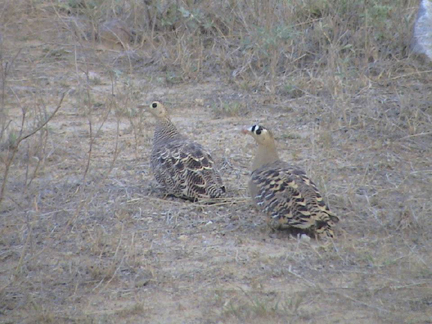
Painted sandgrouses-Pair seen in Bhatti mines
Among mammals are the 3 species of Mongoose, Indian Crested Porcupines, Golden Jackal,Bluebulls,Black Napped Hare and a pack of Striped Hyena are the latest additions in the list as the topmost occupants of the food chain are breeding in Bhatti Mines.
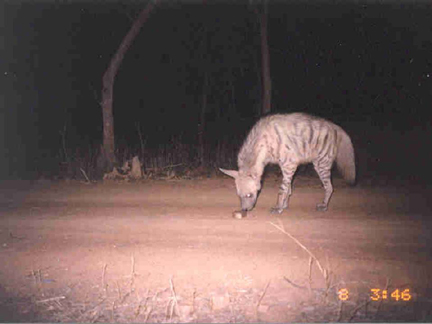
Striped Hyena is breeding in the forests of Bhatti mines
I convey my heartiest congratulations to the entire 132 INF BN (TA) ECO RAJPUT battalion for the restoration of this degraded forest despite many bottlenecks, traffic jams and speed breakers in this journey simply within one decade & specially when UN has
declared year 2011 as an International year of Forests and wish them all success in future. Hope the recent visit of Miss India Earth 2011 will surely help them in the task.
.jpg)
All photographs are by Dr. Surya Prakash. In the above photo he is seen presenting two books to Miss India -Earth(2011) Miss Hasleen Kaur.
|
Eco-travel
Gajner Wildlife Sanctuary
-Dr.S.P Suryaprakash
The city of Bikaner was founded by Rao Bika ji in 1486 and from its small origins it has developed into the fourth largest city in Rajasthan. The Ganga Canal was completed in 1928 and the Indira Gandhi Canal completed in 1987. & both of them have helped the
farming of crops such as mustard, cotton, groundnuts, wheat and vegetables. Today the Central Arid Zone Research Institute has developed its farm at Beechwal which is growing Dates and other fruits also with the help of Indira Gandhi Canal.
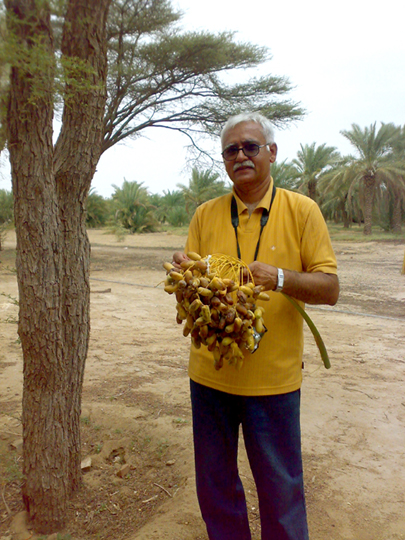
A date with dates
It is amongst top few districts in milk production and hence lot of sweets from milk and milk products are exported from here worldwide. Bikaner is famous for its sweets and snacks (or namkeens in Hindi). Other industries include wool production and the mining
of Gypsum, plaster of Paris and bentonite. Bikaner is situated in the middle of the Thar desert with very little rainfall and extreme variations of temperatures which exceed 50 °C during summer and in the winter it dips to freezing point. Even during my
study period I have experienced the said temperature. Bikaneri Bhujia is a spicy snack made from moth dal, spices and edible oil.
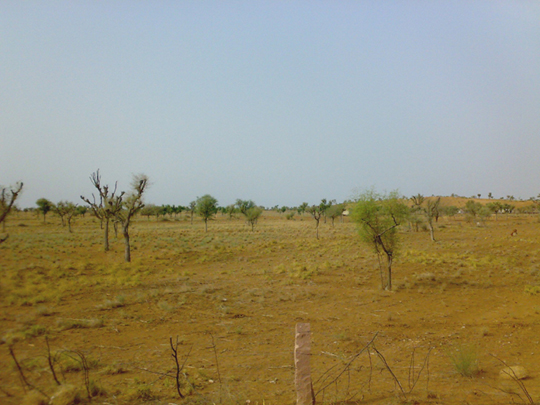
Thar Desert
Bikaner is also known for its handicrafts and leather articles, for its palaces and for having Asia's biggest camel farm National Camel Research Institute. There are are only two in the world the second one is in Australia. The city is also known for its intricately
carved Jharokas. These red sandstone stone jalis (screens) are found on the windows of the Junagarh fort, temples and havelis (mansions of Northern India). Jalis would be used for ventilation and for women to watch the world while remaining hidden. The red
sandstone for these stone window screens was supplied by the nearby village of Dulmera.
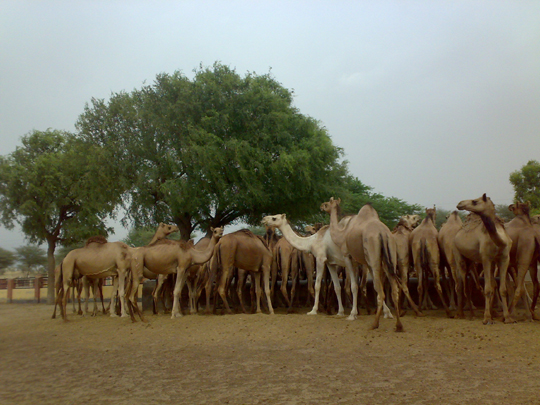
Camels
The Gajner wildlife Sanctuary is located at a distance of 32 kms. from the town of Bikaner. Gajner Wildlife Sanctuary used to be royal hunting grounds of the Maharaja of Bikaner. There is a sparkling lake inside the sanctuary and in the sweltering summer months
one can see a variety of wild animals that come to the lake to quench their thirst.
Apart from being a perennial favorite with the resident animal species of Gajner Wildlife sanctuary, the lake also draws a variety of avian species. The Imperial Sand Grouse is particularly conspicuous by its presence in the winter months. Truly, the sanctuary
is a bird watcher's delight.

Cotton Pygmy Goose
The Gajner Wildlife Sanctuary is home to a number of wild animals and some of the resident species include wild-fowls, deer, antelope, nilgai, chinkara, black buck, desert foxes and wild boars to name just a few. Gajner, the sanctuary provides an ideal opportunity
to watch and photography. The Gajner Wildlife Sanctuary, Bikaner also has Indian Houbara Bustards and Demoiselle Cranes.
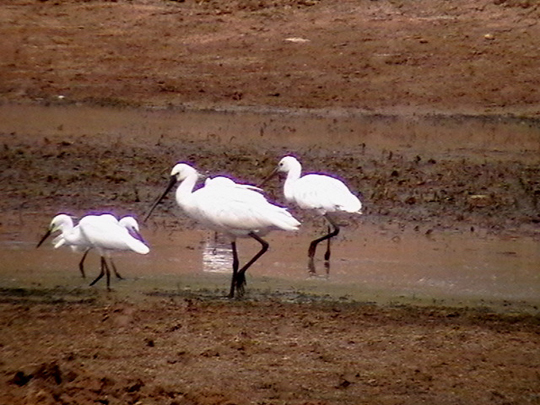
Spoonbills and Little Egret
|
Endangered
Monitoring Tigers in the Twenty-First Century India-Part IX
-Vinod Rishi
Here is the ninth part of an article published by Shri Vinod Rishi in The Indian Forester. Vol.136:10. Wild Life Special.
Shri Vinod Rishi is IFS – retd. and a Former Additional Director General of Forests (Wildlife), Govt. of India; E-mail: vinodrishi@rediffemail.com
(Continued from last month)
Part IX
(3) Evaluation of the Experiment
A great amount of skepticism about the findings from the experiment was voiced but not documented. The source of skepticism will be apparent from a revisit to the experiment conducted in the zoo.
i. Flaws in the concept and design of the experiment:
Prima-facie, the errors and incongruities in the premises crept into the design and conduct of the experiment. The ambiguity in the basic premise prevents the association of the experiment with either of the field methodologies.
a. The design of the experiment did not follow either the Co-operation Tiger Census method or the ‘Pugmark Census’ Technique in its approach. Choudhury had emphasized that “the tiger pugmark is one of the reliable parameters when the impression is true in
size and features, which happens on thin powdery surface soil … a pugmark of a tiger taken from sand or fluffy soil cannot give reliable comparison with that of another tiger taken from thin powdery surface soil” (Choudhury, 1970b). The experiment by design
presented pugmarks on two substrates for testing the participants and making a conclusion about the methodology.
b. The claimed length of experience of the participants should have been established beyond doubt. In practice, Project Tiger organized tiger census once in four years at National level and once in two years at State level. For the participants to acquire
experience of 4 to 6 census years they would have had to spend a minimum of 7 to 11 years on postings in tiger conservation units. Similarly, for the experience of 12 census years the said participant would need to spend 23-24 years on such posting(s). Given
the tenures normally allowed by the government to the wildlife managers there is a chance that the reported length of experience with tiger census was misrepresented. Some of the participants may have had experience with census work on only one or two occasions!
ii. Flaws in the conduct of the experiment
a. The experiment stopped at asking the participants to identify tigers from a single parameter – the pugmark. The experiment did not provide the participants with the range of information used in either the ‘Co-operation Tiger Census’ technique, or the
‘Pugmark Tiger Census’ technique for elimination of human bias and duplication in counting tigers. The missing parameters were: location from where pugmarks were collected, the average stride and straddle of the tiger, and the placement of the tigers’ pugmarks
with respect to the direction of their movement. Inadequate data was presented as a part of the design of the experiment.
b. No replications of the experiment were carried out – the interpretation of results was made from a single sample survey.
(a) In the experiment a serious anomaly was visible: 70% of the participants had made statistically significant correct choices in distinguishing the sex and the pugmarks of tigers, yet they had completely failed in identification of individual tigers and
tiger counts. There was an imperative need to further investigate into the source of anomaly. Scientific research protocol also demanded replication of experiment with different sets of participants.
(b) Replications with different set of participants were also called for since tiger census was being practiced in other States, too. It would have eliminated any chance of the participants having been exposed to a non-standard method. But there was no such
replication of the experiment.
(To be continued)
|
Endangered
Monitoring Tigers in the Twenty-First Century India-Part VIII
-Vinod Rishi
Here is the eighth part of an article published by Shri Vinod Rishi in The Indian Forester. Vol.136:10. Wild Life Special. Shri Vinod Rishi is IFS – retd. and a Former Additional Director General of Forests (Wildlife), Govt. of India;
E-mail: vinodrishi@rediffemail.com
(Continued from last month)
Part VIII
ii. Error In Setting Standards For
Comparing Population Parameters In Different Ecosystems
a. The standards used for comparison of densities and biomass between ecologically different tiger conservation units were not scientifically robust and valid. The dissimilarity in the basic structure of the ecosystems, quality and quantity of
productivity of resources that contribute to the growth and secure persistence of tiger populations in an area come in the way of making scientific comparisons among dissimilar ecosystems.
To illustrate: Research studies had shown that tigers preferred riverine forests and grassland habitats in Chitwan region (Sunquist, 1979). Because of their bio-geographical consonance and similar ecosystems the results from studies carried out in Chitwan in
Nepal may be applicable to Dudhwa tiger reserve in India, and those carried out in a part of Kanha National Park to the rest of Kanha tiger reserve; but they are not applicable to the bio-geographically and ecologically different tide-affected mangrove swamps
of Sunderbans because of their systemic differences, because they do not have riverine forests and grasslands, and the continuous rise and fall of tides inundate and drain out tidal water from the tiger’s habitat. Tiger habitat is in perpetual flux; the land
surface is perpetually expanding and contracting due to the tidal rhythms; the tigers’ prefer to rest and breed in the extensive stretches of Phoenix paludosa on higher land. There is no ecological consonance among the Terai, central Indian plateau forests,
Sunderbans, and other tiger habitats situated in different landscapes and bio-geographical zones and biomes. For applying a common yard-stick to all one has to first establish its validity.
In many tiger reserves, cattle biomass is a significant addition to the prey base of tigers, and it contributes to the growth of tigers. Contrary to the assertion made in the review, that all cattle-kills are reported in India because compensation is paid for
them, the facts are different. The carcasses of cattle killed are often not available to establish the claim for compensation, the compensation amount is too meager, and the process to claim it too cumbersome. For this reason quite a good number of kills miss
getting recorded in the books. The situation in 1970s and 1980s was even worse. The indeterminate nature of this addition also cannot be ignored.
Therefore, the wide variation in tiger densities and tiger biomass shown in the census results of 1984 in India cannot simply be explained away by supposed difference in protection standards or errors in census methodology, without eliminating the effect of
divergent inputs in ecological productivity of resources affecting the growth of tigers in these habitats.
b. Historical records also
do not support the assumed rigor of 11 km2 to 17 km2 per tiger for universal application as a standard range of densities a good habitat can attain. Tiger hunting bags recorded by different hunters in the past contradict such assumptions. “In quiet jungles
of north ASSAM, where game was plentiful and men scarce and tigers suffered a minimum of persecution, Hanley found that ten or twelve tigers were often in the same jungle block of twenty or thirty square miles…” (Imam, 1970). It is equivalent to a minimum
of ten tigers in thirty square mile and a maximum of 12 tigers in 20 square miles, corresponding to densities of 7.5 km2 per tiger to 4.12 km2 per tiger respectively. Maharaja of Bundi estimated 75 tigers in 300 sq miles (750 km2) of his forest (Sankhala,
1978), which gives a density of 10 km2 per tiger in a dry deciduous forest of Rajasthan, higher than the densities in the researched areas.
iii. Error in the Logic of the Analysis:
Even if one concedes the erroneous presumptions made in the review, there is no logic in leading to a conclusion that the census methodology was at fault because 6 out of 18 tiger reserves (33%) exceeded the expected confines of the assumed standards for tiger
density and biomass.
(To be continued..)
|
Events
Visit a butterfly garden!
Ovalekar Wadi Butterfly Garden,Ghodbunder Road,Thane(W) .
1. charges:-Rs.50/-per person (including photography & butterfly watching).
2. additional charges:-Rs.30/-(for breakfast & tea).
3. timing:- 8:00 to 12:30.
4. note:- open only on sundays
5. website:- http://ovalekarwadi.tk/
6. facebook page :- http://facebook.com/OvalekarWadiButterflyGarden
7. FOR MORE DETAILS contact Mr. RAJENDRA OVALEKAR {contact no.:- 9820779729 / 9869256054}
Herpetology Workshop @ Rom Whitaker's
Friday, August 12 at 11:00am - August 15 at 11:00am
The group will leave Bangalore early morning on 12th August and will return around 5 pm on the 15th.
Understanding field survey of reptiles – Single species transects, multiple species transects
· Understanding spatial preference and use of microhabitat by reptiles – Habitat survey
· Documenting nocturnal animals – Camera trapping, night surveys
· Tracking skills – Irula walks, searching artificial refugia and natural hides
· Taxonomy of reptiles– scale counts, scute analysis
· Morphometric data collection of reptiles – measurements and other physical data
· Captive management – feed preparation, enclosure management, feeding and enrichment
· Discussions and presentation by Rom – Snake-bite, Snake-bite management, on-field talks
*Participants will be given a certificate at the end of the workshop signed by Rom.
To register or to know more please get in touch with Soham on +91- 9972068900 /soham@gerrymartin.in
Basics of Photography Workshop - 6th &7th Aug 2011
Saturday, August 6 at 12:00am - August 7 at 7:00pm, at Jaipur
Venue - Kalaneri Art Gallery, JLN Marg, Jaipur.
Mentor-Ashish Sharma, an alumnus of Light and Life Academy, Ooty
For registration click on the given link :
http://form.jotform.com/fo?rm/12062459843
Fee - Rs 1600
Photography Basics
History of photography
Understanding the camera and its essential parts
The Thought Process of good photography
How to produce a body of work
Discussion on some inspiring work of masters
Ethics and practices
Digital Post Processing
|
Events
Reptile Biology Workshop
Monday, July 4 at 8:00am - July 8 at 6:00pm
Location Madras Crocodile Bank
The Gerry Martin Project
More Info
We will be working on reptile biology here, focusing on management of reptiles in captive conditions. There is also a very interesting field component to this program. To enable us to focus on non-captive scenarios, we will also be heading out one morning with
the legendary Irula Snake Catchers and experiencing their incredible bush wisdom and skills.
Children will get hands on experience by working with the staff and specialists at the Croc Bank as well as shadowing the Irulas during their snake hunt. Some of the topics addressed are Reptile Captive Management, Safety Protocols, Small Wildlife Tracking,
Reptile Veterinary Care, Survey Techniques, Field Techniques in Crocodile Research, Snakebite First Aid Protocol, etc.
Dates: 4th to 8th July 2011
To register or to get more details, please get in touch with Conan on 9972068300 or email at conan@gerrymartin.in or Gerry on 9845779666 or gerry@gerrymartin.in.
Naturalist Skills Workshop
Thursday, July 14 at 8:00am - July 17 at 2:00pm
Location Rom Whitaker's
The Gerry Martin Project
More Info
Rom Whitaker is a pioneer in reptile conservation and has been at the forefront of the field for around four decades. He founded the first snake park in India, the Madras Crocodile Bank Trust, Andaman and Nicobar Environmental Team, Irula Snake Catchers’ Co-operative
Society among many other achievements and endeavours.Rom now lives on the edge of a reserve forest about an hour away from Chennai. He has set up a small campsite t...o allow enthusiasts to experience Nature and also build skills in field biology.
The Gerry Martin Project will be taking a group of 18 kids over to Rom’s campsite to run them through the basics in field biology. They will learn outdoor skills, camera trapping, biostatistics, reptile biology, bird watching and a lot more.
Dates: 14 to 17 July 2011
Age bracket: Open for all; kids below 10 years of age should be accompanied by parent(s)/guardian(s).
To register or to get more details, please get in touch with Conan on 9972068300 or email at conan@gerrymartin.in or Gerry on 9845779666 or gerry@gerrymartin.in.
Monsoon Rainforest photography expedition
Saturday, July 23 at 7:00am - July 24 at 8:30pm
Location Agumbe
More Info
The monsoons are here, and together with Nikon we bring to you our flagship expedition in to the heart of western ghats. A monsoon photography expedition of a lifetime to Agumbe's thick evergreen forests that receive the second highest rainfall in India.
Here's your chance to photograph some of the most beautiful waterfalls, landscapes, endemic species of plants, reptiles and amphibians and camp at India's first Rainforest resea...rch station. You will also learn how researchers work in the field first hand
and trek through the pristine forests which are home to several rare and endemic species of animals which are to be found no where else on the planet.
To help you understand and photograph the bio-diversity, You'll be with Wildlife photographer Amoghavarsha, and Researcher Gowrishankar,
who'll guide you through photography, natural history and bio-diversity.
You will also have an opportunity to try out some really amazing Nikon gear and interact with Nikon professionals during the expedition.
For more information visit
http://amoghavarsha.com/workshops/agumbe
TO REGISTER NOW...
Call Amogh +91 9901044344
Mail mail@amoghavarsha.com
Size of group is limited so do hurry
|
Green Defenders
REPTILE RESCUE SQUAD - FLAPSHELL TURTLE
by
Aditi Baindur
If you are a tortoise and go for a very long walk on the CME campus far from your home, you may very soon find that you are back where you started from and named ‘Myrtle’ on top of that.
It was during the summer holidays last year that my Dad got a call at office from Bhattacharya Uncle. His daughter Shreya had found a tortoise in the garden. What, he asked, should be done? Naturally, Dad felt, it had to be restored to its habitat.
He picked me up, our tortoise books and we soon reached Bhattacharya Uncle's bungalow adjoining Holloway School. The turtle was in the lawn surrounded by Shreya and Priyansh, Bhattacharya Uncle's kids and Shrey Kamoji. It had withdrawn itself into its shell.
The back was coloured “muddy-shoddy, grey, brown, black, ochre”. It had three black stripes on its head.
I picked it up and turned it over. We saw that had got flaps to hide its legs under and realised that this was the Indian Flapshell Turtle or Lissemys punctata.
Now the turtle struggled to be put down. No sooner had this been done than its knobby, ridgy sleg with claws emerged and it scurried away along the lawn but was repeatedly recaptured while we pored over our books. We wanted to know why the turtle was wandering
so far from the CME lakes. Our handbook by J.C. Daniels had this to say -
“the adults and young make long journeys during the rainy season, which is probably the reason for the species being so widespread….”
Indian Flap-shell turtles are the “aam janta” in the turtle community of CME and occupy the four lakes and the river. They are also found amongst the reed-beds, ponds, quarries and marshes and the 2 km long rowing channel. The nearest water body or marsh
to Bhattacharya Uncle's house is more than a kilometer away.
The turtle had crossed roads, houses, gardens, fences, ditches and braved the dangers of stray dogs and turtle-eating people to land up where it did! If allowed to roam free, it would head deeper and deeper into the CME campus and surely would be killed.
Shreya asked ‘is it a boy or girl’? Since it is nt easy to identify the sex of a turtle just by looking at it, the children decided, (two girls both older vs two boys both younger), that it looked feminine and soon names for ‘her’ were being proposed. It
was decided that her name was actually “Myrtle” and that she would be a very good pet! Undying vows were made to look after the creature if only they could have it please, pleeassee...
Mindful of what the parents would have to say to this, Dad pointed out that Myrtle fed on shrimps, insects and worms from within the water (they actually eat that and some vegetation too) and her family was probably missing her.
It was decided to restore Myrtle to her home. Everybody set out in our red Maruti van for the rear Nashik gate. There Myrtle was released at a suitable spot upstream into the marshes near the CTW lake. The last photo that we have of Myrtle is of a grinning
Shrey Kamoji holding the turtle last before its release. And the reason for that is, as soon as we set it on the ground some good seven-eight feet from the water’s edge, Myrtle became greased lightning and vanished before we could photograph her!
So Myrtle the turtle went back to tell tales to the grand-turtles with a new name to boot.
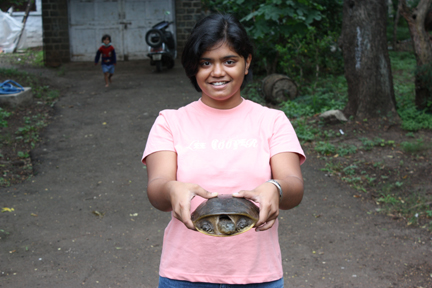
Shreya holding the Flapshell turtle that she found
Image credit - Ashwin Baindur
|
Green Defenders
REPTILE RESCUE SQUAD - PYTHON
by
Aditi Baindur
We went to Goa during our December holidays. The crowded, polluted beaches disgusted us and we went in search of the old historic Goa nestled under the foothills of the Western Ghats. We visited the Butterfly Conservatory of Goa in Ponda, where we saw the
amazing Southern Birdwing, Malabar Peacock and Clipper butterflies. We stayed in a suite on the first floor of our host Prasad Uncle's house (bed and breakfast type facility). They were very hospitable and we had a great time visiting the churches and sanctuaries
of old Goa.
The first day, Prasad uncle brought us a sumptuous dinner but said he was in a hurry to go as he had just received a call to rescue a python. Naturally, CME's own Reptile Rescue Squad immediately lost interest in dinner and accompanied him for the noble
deed. It was very exciting. Till now, we had only caught common snakes and we had never rescued a python before. Prasad Uncle drove with full speed through the deserted streets of Ponda. We arrived outside a walled compound with metal gate. There in a drain
along the wall was the snake hidden by the curious crowd.
The python was huge and half-filled the drain with its coils. Prasad uncle jumped fearlessly into the drain and pounced on the snake. With his left hand he gripped it behind the head and with his right hand and feet he pressed down the coils. The snake
struggled but Prasad Uncle's hold was like that of a wrestler - the python was immobilized. We fetched a large sack from the boot of Prasad Uncle's car and he began lifting the snake out shifting his right hand grip to prevent the python from coiling around
his arm or body.
The python was a female and weighed between 40 and 50 kg and was at least twelve feet long. Males are much smaller. This enables males and females to catch different-sized prey in the forest and they do not compete with each other. As it struggled it released
a musky odour. Uncle carried it home and kept the secured sack in a store-room. Two days later, we were to go to Bondla sanctuary where he planned to release it into dense forest.
We really admired Prasad Uncle's technique and confidence. East Goa being forested has many snakes and Prasad Uncle was called out almost every day, sometimes three or four times. The Forest Department had got tired of rescue calls after office hours and
Prasad Uncle and his friends provided a free unofficial Reptile Rescue Service in different parts of Goa.
But this was only the first of many rescues. Over the next two days, Prasad Uncle was called again and again to the same spot where he caught five more pythons, one by one. They were all males - probably the female python was ready to mate and the males
had been attracted by the musk. We helped him catch two of these males.
The next day, we took a car dickey full of pythons to Bondla and released them one by one. The female was released first and she immediately climbed up into a bamboo thatch nearby. She was huge, large and so much thicker than any of the bamboo shoots but
immediately vanished from sight - a perfect example of nature's camouflage. The male pythons were released twenty minutes apart at different locations - two of them vanished as a weaving ripple into a nearby pond while the others dispersed in different directions
into the forest. We really felt good that six endangered snakes were safely rescued from urban Ponda and released into the wild.
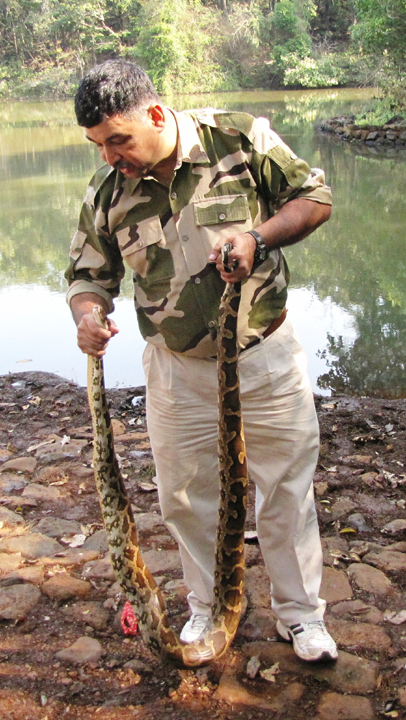
A male python being released by my Dad
Image credit - Nandan Kalbag
|
News and Views
News....
Dear friends,
We need your support!
We are very excited to be entrants in the eBay Foundation and Ashoka's Changemakers Competition, Powering Economic Opportunity-Create a World that Works. This is a global competition to find the world’s most innovative market-based solutions that create economic
opportunity and generate employment for disadvantaged populations.
By being part of this competition, we have a great opportunity to initiate our off-line project “Wilderness Conservation Volunteers” and also to promote our work in IndianWildlifeClub.com.
The competition is an open platform where we can share our work with the world, so the more people we can inspire, the better!
Please help us rally support for our work:
1. Visit our project entry
http://www.changemakers.com/economicopportunity/entries/wilderness-conservation-volunteers
2. Leave us feedback about our entry. Here's how:
a. If you do not have a Changemakers account, please click
here to register on the site. It only takes a couple of minutes.
b. Login at the Changemakers
website.
c. Go to the
Powering Economic Opportunity: Create a World that Works
d. Visit our entry, read about what we do and leave your feedback!
http://www.changemakers.com/economicopportunity/entries/wilderness-conservation-volunteers
e. Update your profile and be part of a growing online community of support!
3. Spread the word to your colleagues and friends through your emails, blogs, or websites. I've included some information about us below that you are welcome to share with others.
Indianwildlifeclub.com (IWC), a Community of Practice (COP)in existence since 2000 has aimed at making wilderness conservation a day to day concern for the common citizen. IWC has networked with NGOs/Government and experts working
in wilderness areas and now wish to set up an online Exchange for bringing Volunteers, NGOs/Government Agencies and Funders together. This online exchange will improve effectiveness of on-ground activities taken up by NGOs. IWC will undertake to train Volunteers
for suitable NGO/Government Agency Projects and monitor,document and archive the data gathered by Volunteers. The aim is to bring transparency to NGO-Volunteer-Funder interface. By leveraging our online presence IWC seek to make a sustainable contribution
in wilderness conservation in India.
This contest can give our work a great boost. Thank you very much for your help!
Susan Sharma
Views.....
Our artcle in the May issue (Author Prajakta Hushangabadkar) on illegal trading of turtles has received some comments from Vikrant Saggar
Comments on
http://www.indianwildlifeclub.com/Ezine/View/Details.aspx?aid=717
Illegal trading of Assam roofed terrapin - Indian Wildlife Club Ezine - May, 2011
Indian Wildlife Club Ezine
"I think here's an identification Prob. To my knowledge these R Red-Eared Slider (Trachemys scripta elegans), yes the fact about there sale in pet shops is true. these r captive bred in USA for the pet industry licensed by the Louisiana Department of Agriculture
& Forestry. even a lutino mutation is being developed lately. there is no prob in their sale in india as long as a bill & a certificate saying that they R "salmonella free" is catered by the pet shop owner.

Our online chat -an interview with Dhaval Patel of Vidyasagar Nature Club which can be read here also got some comments worth sharing.
http://www.indianwildlifeclub.com/chat/chat-archive.aspx
"I read the transcript, can't say that I read them each time, but I did read this conversation between you and Dhaval Patel. I think the mock currency and fake mall idea is quite brilliant. Its a bit naive to think that with rampant consumerism all over the
place, children from poorer backgrounds would want to curb their enthusiasm for shopping or getting nice items.
Its a clever way to get kids those items while teaching them the importance of value that money represents rather than money itself".
Akshay D
|
Our choice from facebook this month
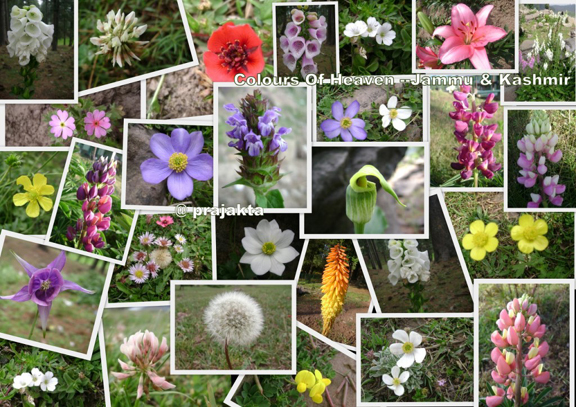
Prajakta is on a trek in Kashmir and posted this picture of the wildflowers she encountered
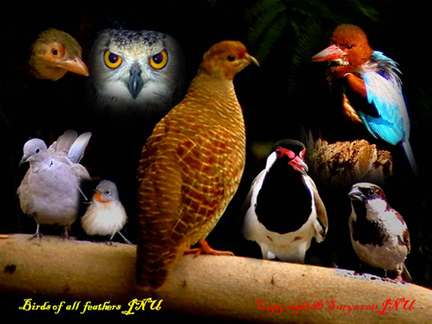
Dr.Surya Prakash posted a collage of birds which visit his JNU home in New Delhi
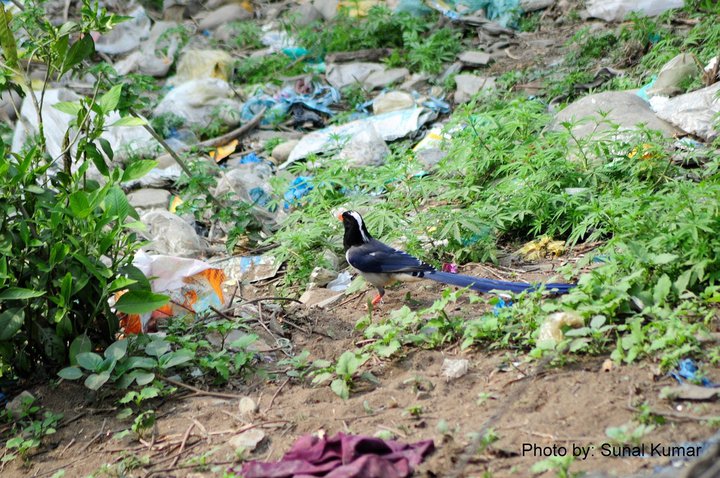
A magpie looking for food among trash. Trash harming the animals. Picture taken by Sunal Kumar Roamin for Take Pride. A Project by Whispers Inc. USA
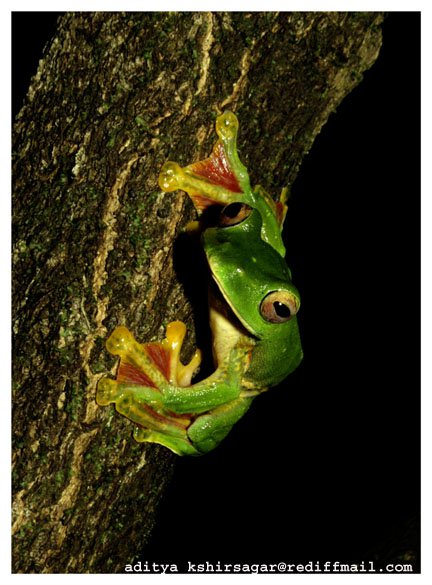
Malbar gliding frog...My first frog post on facebook this monsoon...Added by Aditya Kshirsagar to the group "DiversityIndia"
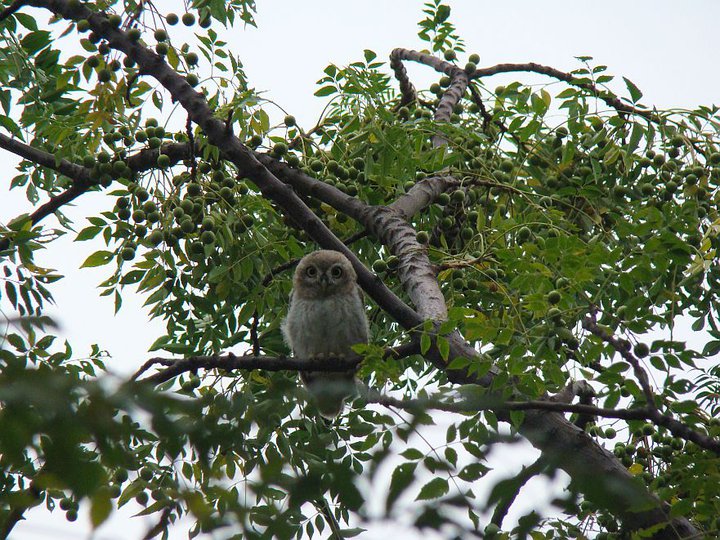
"Young and Fiery Spotted Owlet".
Today morning in my colony. Like several other areas in Gurgaon, owlets are nesting in my colony too. Today I had camera with me to capture it. Added by Soma Ateesh Tripathi to the group "Indian Birds"
|
Our choice from facebook this month
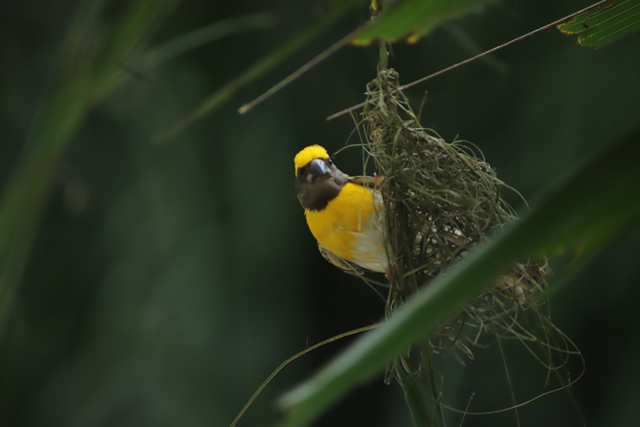
Baya weaver-it's monsoon and mating time for baya nowadays. Males are working hard to impress their mates.
Posted by Mayank Tiwari in the facebook group "Indian Birds".
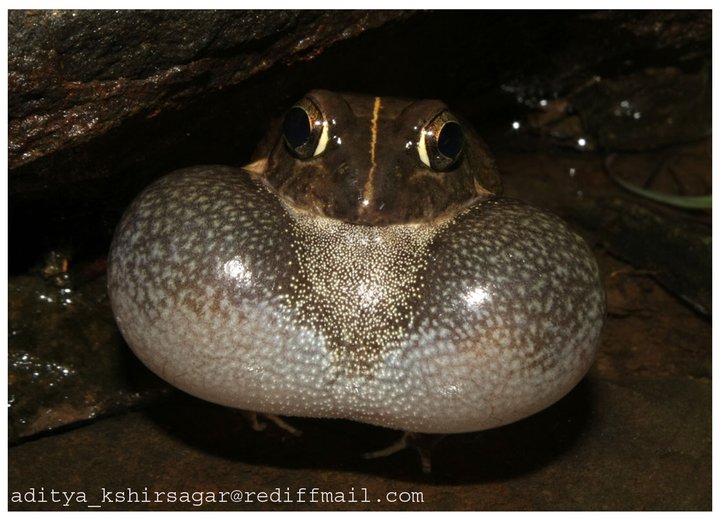
Burrowing frog(Sphaerothecabreviceps)-Posted by Aditya Kshirsagar in the facebook group "DiversityIndia"

Elephant
Photo by Prakash Natarajan
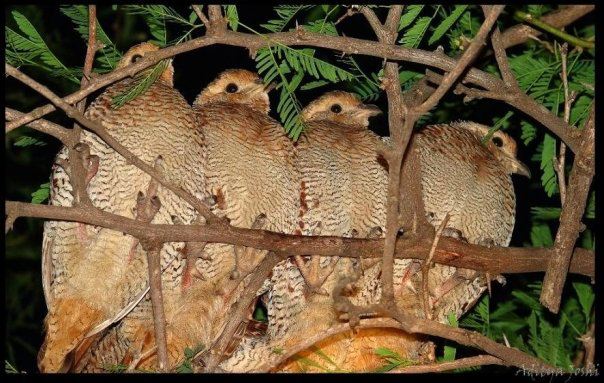
Grey Francolins -roosting- Posted by Aditya Joshi in the facebook group "Indian Birds".
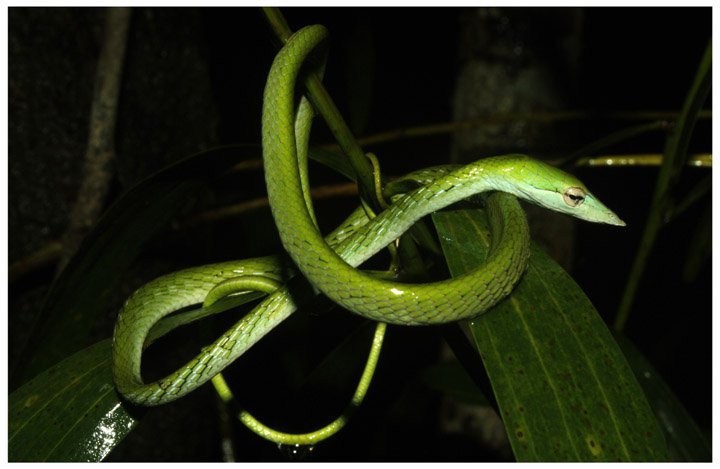
Green vine snake...Resting at night-Posted by Aditya Kshirsagar in the facebook group "DiversityIndia"
A
|
Poem
Lyrics: Vairamuthu Ragam: Ritigowlai
Music: Sujatha Vijayaraghavan Talam: Chatusra Ekam
I Shall Sing of Trees
Tree
Creation’s painting
Exclamation mark of the earth
Contemplating the tree
A heart warming experience
Boughs
Angling for the stars
Leaves
Wherein laughter is poured
Blossoms
Brimming with life
Wisdom that Man gives not
Tree will give me.
To birds and animals
Assurance the tree gives
Do we humans give?
Fruit to eat – Shade to rest
Balm for the body – Feast to the senses
Hovel for haven – Door to bar
Fence beauteous – A hammock to swing
Unguent to smear – Oil to season
Paper to write on – Fuel to burn
It is the tree (Maram Thaan)
It is the tree (Maram Thaan)
All from the tree
Forgotten (Maran Thaan)
Forgotten (Maran Thaan)
Man has forgotten
Ah man!
Do you wish to turn human?
Come unto the tree!
Everyone is a Bodhi tree.
- Excerpts from the poem in Tamil by Vairamuthu
- Translated by Sujatha Vijayaraghavan
(The song is an extract from the Pudu Kavithai “Marangalai Paduvane,” by the famous contemporary poet Vairamuthu. The poet describes the beauty and utility of trees and their role in the cycle of life. Man has forgotten the bounties he has received from trees
and indulges in large scale felling and destruction of his benefactors. Every tree is a Bodhi tree, says the poet, punning on the word “Bodhi”, which as an adjective means “one who gives precepts.” The unequal lines of the poem have been set to Chatusra Eka
talam, the easy flowing rhythmic cycle of four beats and the ragam chosen to bring out the meaning of the lines is Ritigowlai. The repetition of the word “Maranthaan,” which is a pun denoting the tree and man’s ingratitude, is sung like a chant.
This was the first Pudu Kavithai to be performed in BharataNatyam and was staged for the first time on 27th December, 1992. It was set to music by Sujatha, choreographed by Rhadha and danced by Sunanda for the Nrityagitaanubhavam Prakriti
See clips from this performance at https://www.youtube.com/watch?v=WrhgJytYXXQ
|
Wildlife Photolog
The Jungle Cat goes on hunt in Velavadar, Gujarat
By
Ajay Jain
The Blackbuck National Park in Velavadar, Gujarat is a delightful place to spot many species. With the right guide, you can see some rare sights. Like I did of the Jungle Cat out on a hunt.
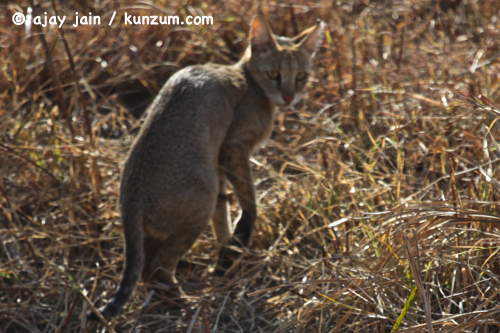
A Jungle Cat looking toward me - what was she checking me out for?
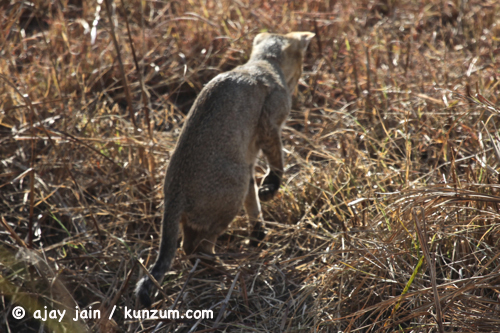
The Jungle Cat is camera and people shy. I was not just lucky to spot one, but it also stayed put. Why? It was out hunting for food. Rats specifically. Seen here is the cat is a still position mapping out the target.
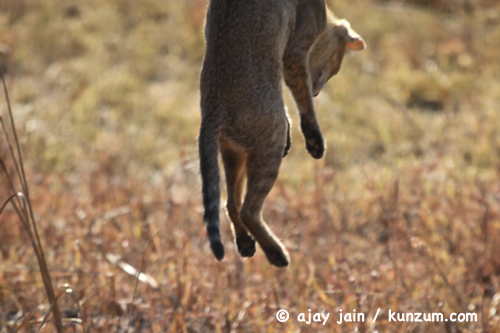
As I watched, the Jungle Cat stood still in a crouching, alert position for a long time. And then it jumped. Literally. High up in the air to grab its prey. Seen here is the cat going up.
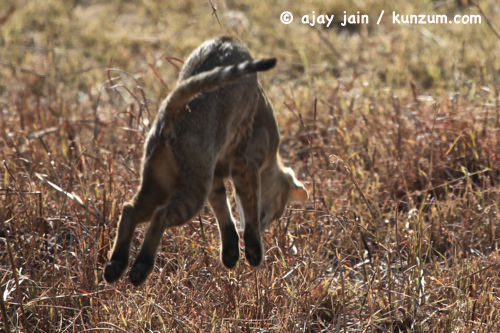
And here she is coming down. She would miss her prey.
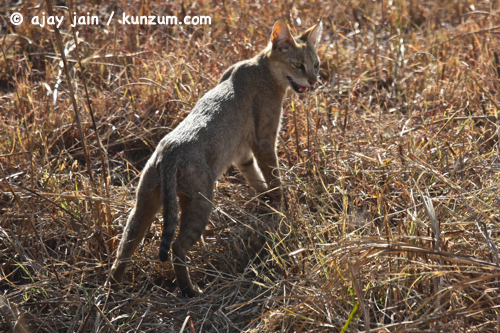
The cat has a sheepish, silly grin for having missed especially when she had an audience waiting to applaud. She can no longer make eye contact, embarrassed as she is. Time to walk away - pride hurt, stomach empty.
- Ajay Jain is a travel writer and photographer and shares his stories on www.kunzum.com. He can be contacted at ajay@ajayjain.com
|